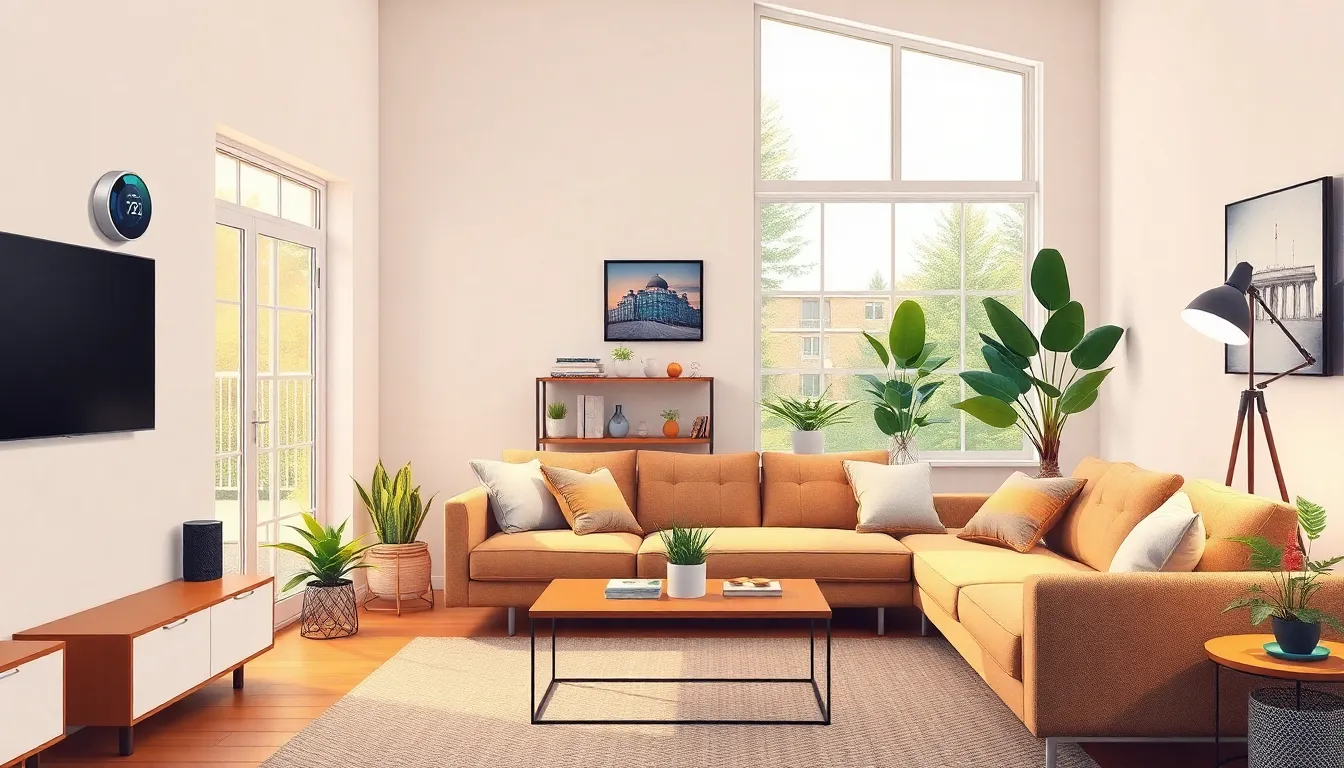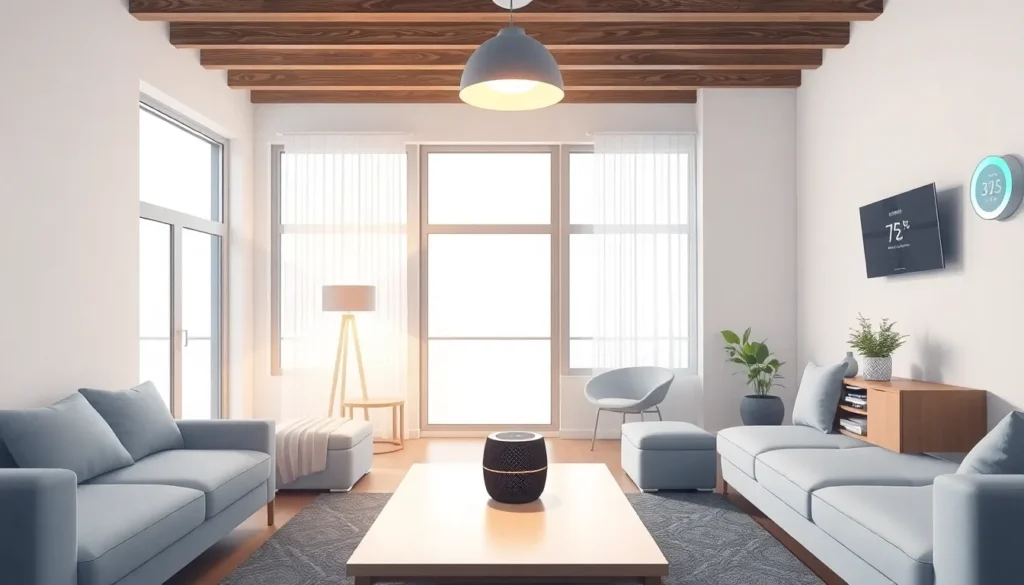Table of Contents
ToggleImagine living in a home that knows you better than your best friend. That’s the magic of IoT home devices. These smart gadgets don’t just sit around looking pretty; they’re here to streamline your life, keep your home secure, and maybe even remind you to water that poor, neglected plant in the corner.
Overview of IoT Home Devices
IoT home devices utilize internet connectivity to create smart solutions for everyday challenges. These devices range from smart speakers to thermostats, each designed to enhance the user experience at home. Smart speakers, for example, allow users to control other devices through voice commands, stream music, and access information instantly.
Thermostats equipped with IoT technology can learn individual preferences, adjusting temperatures for optimal comfort. Security cameras with smart features enable homeowners to monitor properties remotely, offering peace of mind. Smart lighting systems also contribute to energy efficiency, allowing for automated scheduling and control through mobile apps.
Home automation solutions go beyond convenience. They promote energy savings by optimizing the use of electricity and reducing waste. Through data tracking, IoT devices gather insights that help users make informed decisions regarding energy consumption.
Connectivity plays a vital role in how these devices interact. Wi-Fi and Bluetooth enable seamless communication, allowing devices to work together within a smart home ecosystem. Integration with platforms like Google Home or Amazon Alexa further enhances user control and personalization.
Users benefit from convenience with reminders and notifications. Devices can alert individuals when it’s time to water plants, take medication, or even lock doors. Daily tasks become simplified, leading to a higher quality of life.
These technological advancements show the potential of IoT home devices to revolutionize living spaces. Adopting smart gadgets not only supports personal well-being but also aligns with modern lifestyles. Increased adoption continues to shape the future of smart homes.
Benefits of IoT Home Devices

IoT home devices offer various advantages that streamline daily living. Enhanced connectivity leads to smoother interactions between devices, promoting an overall better living experience.
Increased Convenience
Convenience serves as a primary benefit of IoT home devices. Smart speakers respond to voice commands, controlling lights, thermostats, and appliances. Automated routines become possible, such as scheduling lights to turn on at sunset or adjusting the thermostat before arriving home. Notifications from security systems keep users informed about important events, empowering proactive responses to potential issues. Simple adjustments, conducted through apps, eliminate the need for physical presence, making everyday tasks more manageable.
Energy Efficiency
Energy efficiency stands out among the key benefits of IoT home devices. Smart thermostats, for example, learn household patterns and adjust temperatures to optimize energy use without sacrificing comfort. Lighting systems equipped with motion sensors activate only when needed, contributing to significant energy savings. The integration of these devices fosters a more sustainable lifestyle, reducing both carbon footprints and utility bills. As data analytics improve, IoT devices provide insights into energy consumption, allowing users to make informed, eco-friendly choices.
Types of IoT Home Devices
Various IoT home devices enhance comfort and security in modern living environments. These devices offer innovative solutions that streamline everyday tasks.
Smart Speakers
Smart speakers provide hands-free voice control over multiple devices. They respond to voice commands, allowing users to play music, set reminders, and adjust smart home settings. Integration with services like music streaming platforms and virtual assistants amplifies their functionality. Commonly found in homes, smart speakers create a centralized control hub for other IoT devices. Popular examples include Amazon Echo and Google Nest Hub, both offering voice-activated control over compatible devices.
Smart Thermostats
Smart thermostats optimize heating and cooling systems based on user behavior. They adapt to individual preferences, learning patterns and adjusting temperatures automatically for comfort and energy efficiency. Data analytics empower users to track and manage energy consumption effectively. Most smart thermostats connect to Wi-Fi, enabling remote access through mobile apps. Popular brands include Nest and Ecobee, known for their intuitive designs and energy-saving features.
Smart Security Cameras
Smart security cameras enable real-time monitoring of homes from anywhere. They provide features like motion detection, high-definition video streaming, and cloud storage options. Users receive instant alerts on their devices when unusual activity occurs, enhancing peace of mind. Brands like Ring and Arlo offer versatile solutions that integrate with home security systems. These cameras often include two-way audio, allowing communication with visitors or pets at home.
Challenges and Considerations
IoT home devices present several challenges that users must consider. Addressing these challenges ensures a secure and efficient smart home environment.
Security Risks
Security risks pose significant concerns for IoT home devices. Unauthorized access to devices can lead to breaches of privacy. Research indicates that inadequate security measures often expose data to cyber threats. Users may encounter issues such as hackers gaining control of smart cameras or speakers. Regularly updating device firmware and using strong passwords can mitigate some risks. Ensuring encryption protocols are in place protects sensitive information from potential vulnerabilities. Overall, prioritizing security measures enhances the safety of smart homes.
Compatibility Issues
Compatibility issues affect the integration of various IoT home devices. Different manufacturers may use proprietary systems that complicate seamless communication. Users often face challenges when trying to connect devices from multiple brands. Smart home ecosystems like Google Home and Amazon Alexa aim to standardize connections, yet not all devices comply. Research suggests that selecting devices labeled with “Works with” branding can alleviate these problems. Establishing compatibility standards fosters smoother interactions among devices, improving user experience. Prioritizing compatibility during purchasing decisions streamlines the setup process and enhances functionality.
Future of IoT Home Devices
Advancements in IoT home devices promise significant enhancements in user experiences and home automation capabilities. Innovations like artificial intelligence and machine learning will empower devices to predict user preferences more accurately. Smart appliances could begin coordinating tasks seamlessly across the home, creating an interconnected environment that reacts to user needs.
Security will continue evolving alongside these devices. Manufacturers are implementing advanced encryption methods, enhancing data security and reducing the risk of unauthorized access. This proactive approach ensures that home data remains private and secure while maintaining functionality.
Energy management also stands to benefit greatly from IoT technology. Smart devices can communicate energy consumption rates, providing users with actionable insights to lower utility bills and contribute to sustainability. By tracking energy usage, these devices promote eco-friendly practices within households.
Additionally, voice-activated controls are expected to become more intuitive. Natural language processing capabilities will help devices understand context, making interactions smoother and more efficient. An increasing number of households will benefit from these smart solutions, leading to widespread adoption of voice-controlled technology.
Integration with health monitoring features adds another dimension to IoT home devices. Wearable health tech can sync with home systems, allowing users to create an environment that supports wellness initiatives. Home automation might soon cater to health needs by adjusting lighting or temperature based on user health data.
As IoT ecosystems expand, cross-compatibility will improve significantly. Consumers will seek devices that easily connect with existing smart home networks. Selecting products compatible with major platforms ensures that homes remain versatile and future-proof.
The rise of IoT home devices marks a significant shift in how people interact with their living spaces. These smart technologies not only enhance convenience but also promote energy efficiency and security. As users embrace these innovations they can expect a more personalized and connected home environment.
Looking ahead the integration of advanced technologies like artificial intelligence will further transform these devices making them even more intuitive and responsive to user needs. With ongoing improvements in security and cross-compatibility consumers can confidently adopt IoT solutions that align with their lifestyles. The future of smart homes is bright and filled with possibilities that promise to enrich daily living experiences.







